 According to the teachings of Yoga, there is Life after Life: our bodies come and go, but Spirit is imperishable and eternal. We are said to inhabit a series of "vehicles" which we drive along the "information highway" of reincarnation. When one vehicle can no longer be repaired, another one is provided.
According to the teachings of Yoga, there is Life after Life: our bodies come and go, but Spirit is imperishable and eternal. We are said to inhabit a series of "vehicles" which we drive along the "information highway" of reincarnation. When one vehicle can no longer be repaired, another one is provided.
The Bhagavad Gita states this beautifully:
According to the same tradition, our natal horoscope is a symbolic description of our current "suit of clothes" - our body and its particulars, as well as the circumstances and environment into which we are born. We have free will and can change or modify these details, but they are in large measure preconditioned, not as a curse - but as a blessing. These Karmic circumstances provide the optimal environment for our growth and unfoldment. We're not always pleased with the particulars, but without sufficient challenge, life becomes boring and we look elsewhere for fulfillment. (Read more about Karma, Saturn and evolution in this previous chapter.)
The horoscope also shows the forces at play within the mind. A competent astrologer can discern and describe them for any point in time after birth. Hard distinctions between body and mind - our inner and outer worlds - are less rigid in Astrology, which is holistic by design. Astrology gives less of a literal description and more of a symbolic one.
Is Astrology absolutely necessary? No - but it can be extremely helpful if we want to understand who we are, where we've been and where we're headed.
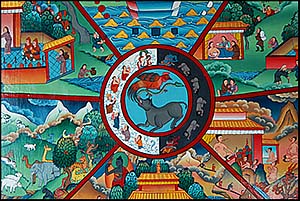 Kriya Yoga teaches that there are 12 basic states of consciousness, 12 modes of being. All are valid, all are complimentary and all are "required reading" in the cosmic school of souls. From lifetime to lifetime, we encounter them all and reach gradual mastery.
Kriya Yoga teaches that there are 12 basic states of consciousness, 12 modes of being. All are valid, all are complimentary and all are "required reading" in the cosmic school of souls. From lifetime to lifetime, we encounter them all and reach gradual mastery.
Influences are constantly changing. If for several lifetimes it's all about wealth, the theme eventually morphs into something else: relationships, creativity, social welfare, etc.
The birth chart reveals which of these themes are active: today, this month, this year and this lifetime. Becoming more aware of these influences and learning how best to respond to them is one of the siddhis - the "perfections" or powers - which we get from the study of Astrology.
According to Edgar Cayce the individual spirit needs to experience every vibration before it can graduate from the School of Life.
From this Jovian perspective (Jupiter), life is a process of expansion. Jupiter (and Neptune and Sagittarius and Pisces) relate to enlargement, travel and education. Over time, we broaden the horizon of our awareness. We grow, we unfold. We reach new levels of consciousness. Every lifetime we get a new horoscope - a new set of Karma - and we take another step towards what Kriya Yogis have called Balanced Self-Conscious Awareness.
 A Sanskrit watchword or affirmation for this process is Aham Brahmasmi: I am the creative principle. (Brahmin comes from the root Brih, which means to swell or enlarge). In the language of the New Testament, "I and My Father are One".
A Sanskrit watchword or affirmation for this process is Aham Brahmasmi: I am the creative principle. (Brahmin comes from the root Brih, which means to swell or enlarge). In the language of the New Testament, "I and My Father are One".
The experience of spiritual awakening is the ultimate destiny of every individual, for as it was written: "Ye are all Gods". In Old Testament parlance, we were made "in the image of God" - but were cast out of the Garden, put into Exile. Over time, with sufficient personal exertion and Divine Grace, we are restored: we reach the symbolic Promised Land, which is not a geographical location, but a state of consciousness.
Jnana Yoga, Zen Buddhism and other wisdom traditions state that we are already divine - but obstructed by the Five Kleshas ("poisons"). As we evolve, the kleshas gradually fade and our inherent divinity is revealed. Individuals are born free, but have limitations that must be transcended, chains of bondage which must be broken. From this more Saturnine perspective, treading the spiritual path is a gradual process of moksha or liberation.
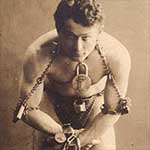 Harry Houdini (1874-1926) is considered one the greatest illusionists and escape artists of all time: his name is synonymous with the craft. It's hard to imagine fame Houdini had during his era... and his horoscope does not disappoint.
Harry Houdini (1874-1926) is considered one the greatest illusionists and escape artists of all time: his name is synonymous with the craft. It's hard to imagine fame Houdini had during his era... and his horoscope does not disappoint.
Houdini's nativity strongly suggests some kind of unusual and mysterious individual. Why? Because that's the "vibration" or "flavor" we get with Libra Rising and ruler Venus closely conjunct Neptune. We get more mystery when South Node Ketu is in the First House, because the first house is the most important house: symbols there take on special prominence. His Moon is in Scorpio, the constellation of secret transformation. His chart has several prominent astrological patterns which speak the same message. But don't take our word for it: get a good book on Astrology and find out for yourself.
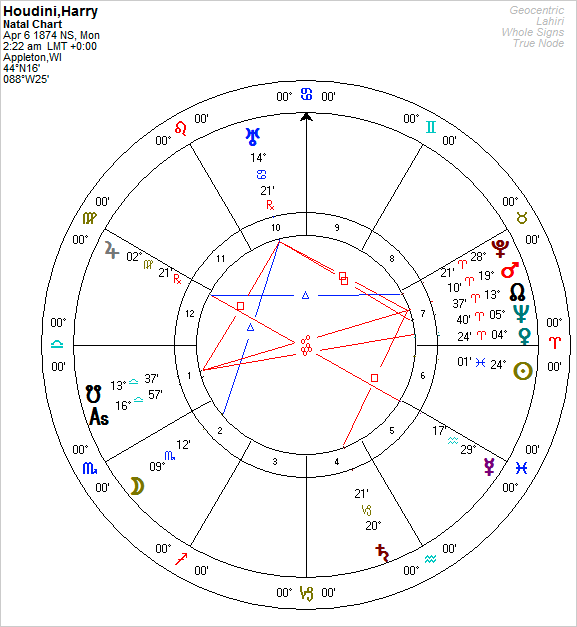
His horoscope contains five planets in Aries. His Mars is in its own sign and Mars in an angular house. This is the well-known Ruchaka Yoga that we saw with King George. If not a warrior, this pattern can easily make one an athlete. It gives heightened physical energy and drive. Self-reliance. Adventure. Such people are risk-takers, or in today's parlance, "adrenaline junkies".
Mars is not only in its own sign on an angle, but conjunct Rahu the North Node: the great amplifier. While one-twelfth of the population may have their chart lord in Aries - and some other twelfth has Mars in Aries - and yet another fraction has Mars conjunct the North Node - very few individuals have all these patterns together. If we haven't already found enough symbols of energy and daring, we can consider Houdini's Pluto in Aries - and his Moon in Mars/Pluto-ruled Scorpio!
Houdini was born on a Uranus station point and Uranus was opposed by Saturn: a perfect symbol of someone who breaks free of confinement. In his case, it wasn't about politics or psychology: a Uranus emphasis in the Tenth House of Profession made "liberation" his career path!
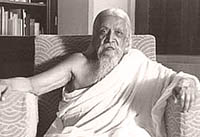 Sri Aurobindo (1872-1950) was one of 20th century India's most influential thinkers. A nationalist and freedom fighter, he later became a philosopher, yogi, guru and prolific writer. As a radical leader of India during their efforts to cast off British rule, he met his spiritual teacher and was initiated into meditation while in prison. Shortly thereafter, a profound spiritual awakening changed the trajectory of his life.
Sri Aurobindo (1872-1950) was one of 20th century India's most influential thinkers. A nationalist and freedom fighter, he later became a philosopher, yogi, guru and prolific writer. As a radical leader of India during their efforts to cast off British rule, he met his spiritual teacher and was initiated into meditation while in prison. Shortly thereafter, a profound spiritual awakening changed the trajectory of his life.
Aurobindo moved away from politics and developed his own vision of human progress and evolution, influencing a generation of thinkers and writers. He promoted the idea of Integral Yoga: the holistic development of body, mind and spirit which today we take for granted as self-evident.
The core of his message is the anticipation of a shift in human consciousness, towards deeper intuition and spirituality. He spelled this out in his book The Future Evolution of Man: The Divine Life Upon the Earth, the text of which is freely available here.
Sri Aurobindo described a natural unfoldment of consciousness from mineral to plant - from plant to animal - from animal to man - and from man to Superman:
His writings brought together elements of Eastern and Western philosophy, religion, literature and psychology. He was the first Indian to create a major literary corpus in the English language. According to Wikipedia "His works include philosophy; poetry; translations of and commentaries on the Vedas, Upanishads and the Gita; plays; literary, social, political and historical criticism; devotional works; spiritual journals and three volumes of letters. His voluminous, complex and sometimes chaotic literary output includes philosophical pondering, poetry, plays and other works. Among his works are The Life Divine (1940), The Human Cycle (1949), The Ideal of Human Unity (1949), On the Veda (1956), Collected Poems and Plays (1942), Essays on the Gita (1928), The Synthesis of Yoga (1948) and Savitri: A Legend and a Symbol (1950)."

Sri Aurobindo's horoscope contains a powerful influence of Jupiter. At the moment of his birth, it was rising in the east, closely conjunct the Ascendant. This makes it the most influential symbol in his chart. Jupiter is exalted in the constellation Cancer: that makes it even stronger. When Jupiter is exalted and in an angular house, Indian astrologers call it a Hamsa Yoga - a "swan pattern" which promises all good things granted by the Great Benefic. If we knew nothing else, we could predict that his life would be filled with the affairs related to Jupiter: opportunity, travel, higher education, freedom, religion, philosophy, publishing, teaching, etc.
At the direction of his father (a surgeon who had trained in Scotland), Aurobindo was sent away to England at the age of seven for a Western education free of Indian influence, under the private tutelage of an Anglican minister. After studying at Kings College, Cambridge University he returned to India as a virtual Englishman, groomed to join the prestigious Indian Civil Service.
Upon his return he reclaimed his original Indian identity and rejected the notion of serving the British. Purposely failing to appear for his horse-riding examination, he ruined his future employment prospects, but his classical training in Greek, Latin and English literature made him ideally suited for the roles he would later assume as a man of letters and a dangerous intellectual in service to his motherland.
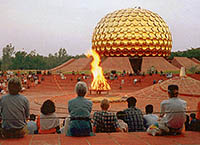 The constellation of the Crab (Cancer) is a symbol of domestic life and Cancer Rising natives are often highly attuned to the importance of motherhood, family and communal living. With a birth time of 5:00 AM - likely an approximation - we have to wonder if the Sun in this chart is in late Cancer or early Leo. A Sun in late Cancer would make him a double Cancer but this remains an open question.
The constellation of the Crab (Cancer) is a symbol of domestic life and Cancer Rising natives are often highly attuned to the importance of motherhood, family and communal living. With a birth time of 5:00 AM - likely an approximation - we have to wonder if the Sun in this chart is in late Cancer or early Leo. A Sun in late Cancer would make him a double Cancer but this remains an open question.
In any event, because the Moon rules Cancer, it's the chart lord in Sri Aurobindo's horoscope and it's placed in Jupiter-ruled Sagittarius. This contributes even more influence of Jupiter and in the Sixth House it makes him a hard worker (see Mozart) and one whose job involves lunar concerns: women, the general public, real estate, domestic affairs, etc.
His partner and collaborator was a French mystic named Mirra Richard - who Aurobindo simply called The Mother. A sage in her own right, she wrote about her psychic investigations into the consciousness of human cells and what Aurobindo called Supramental Truth Consciousness. Seventh Lord Saturn in Sagittarius and Moon in Sagittarius speak of spouses foreign and philosophical. In the Chandra Lagna chart ("Moon Ascendant": using the Moon to denote the first house), the ruler of the Seventh House is in the Ninth House. When a pattern appears repeatedly, prediction becomes easy.
When the lord of the Seventh House is in the Sixth House (or the Sixth Lord is in the Seventh House), there is a tendency for romantic partners to become professional colleagues and vice versa. In Aurobindo's case, Saturn as Lord of Seventh House Capricorn, is in the Sixth House and so is the Moon, the general symbol of women in a man's chart. The Mother carried on Aurobindo's mission for the remainder of her life.
Aurobindo's ultimate legacy may be the futuristic community that he inspired and whose founding The Mother oversaw: Auroville, in Pondicherry India. It was financed by UNESCO and designed by French architect Roger Anger, who made the following statement:
Do we evolve and expand through learning and acquiring, or do we break free by casting off our chains ? Do we receive illumination through Grace and Grace alone - or are we already enlightened - but just don't know it ? Must we purify and redeem ourselves before we can enter the Kingdom of Heaven ? Does awakening come in a flash, or is it developed gradually ? Must we help others to be deserving of help ?
Each of us is different and according to the ancient spiritual teachings, the answer to all those questions is a resounding... Yes !
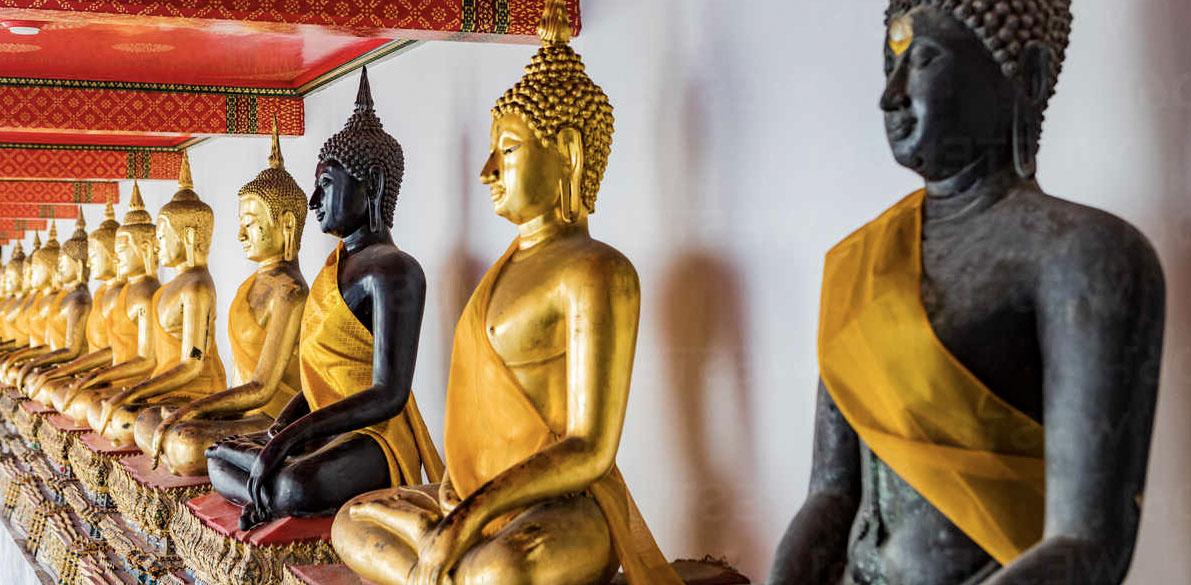 Interested in the horoscopes of other spiritual teachers ?
Interested in the horoscopes of other spiritual teachers ?
See these articles: